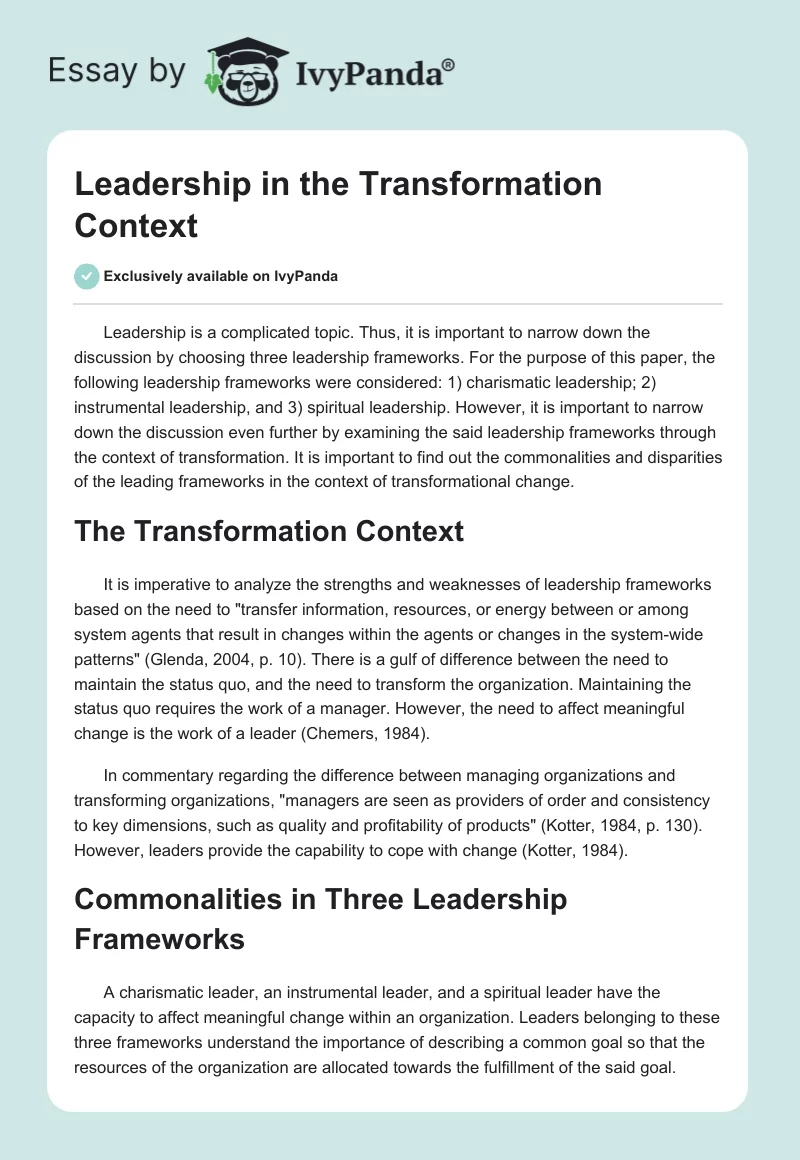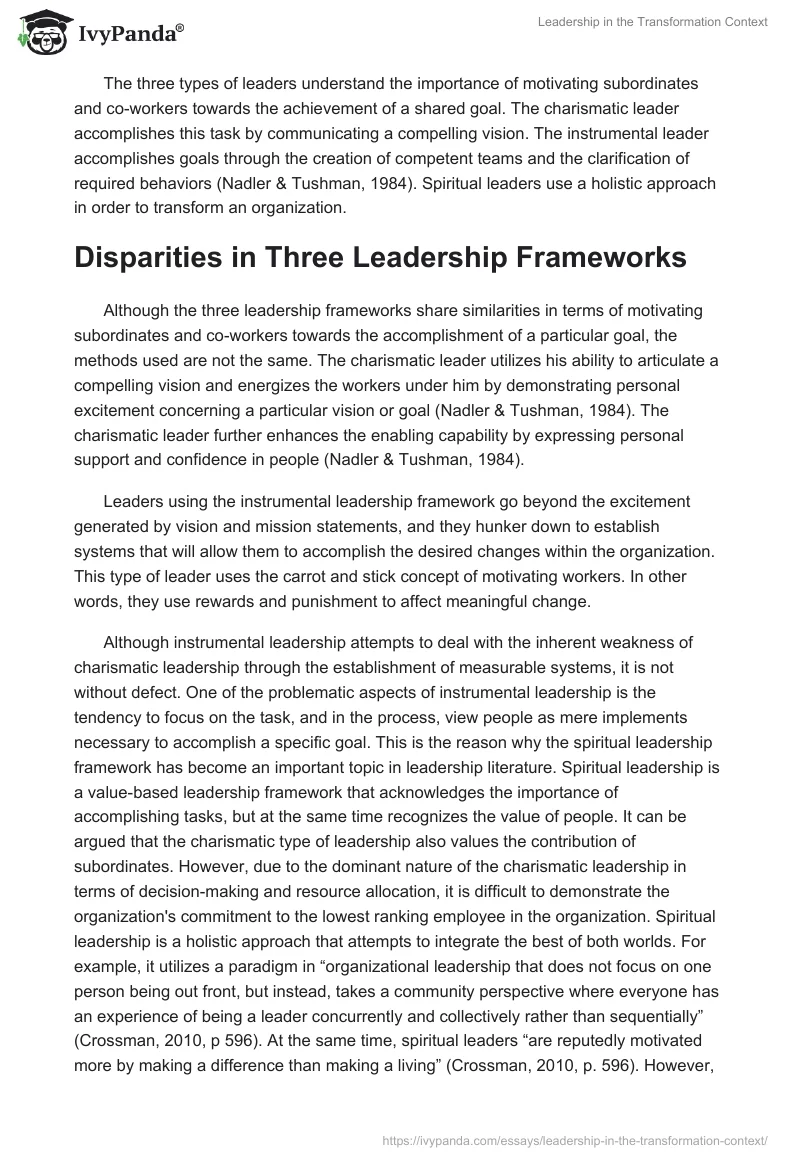Leadership is a complicated topic. Thus, it is important to narrow down the discussion by choosing three leadership frameworks. For the purpose of this paper, the following leadership frameworks were considered: 1) charismatic leadership; 2) instrumental leadership, and 3) spiritual leadership. However, it is important to narrow down the discussion even further by examining the said leadership frameworks through the context of transformation. It is important to find out the commonalities and disparities of the leading frameworks in the context of transformational change.
The Transformation Context
It is imperative to analyze the strengths and weaknesses of leadership frameworks based on the need to “transfer information, resources, or energy between or among system agents that result in changes within the agents or changes in the system-wide patterns” (Glenda, 2004, p. 10). There is a gulf of difference between the need to maintain the status quo, and the need to transform the organization. Maintaining the status quo requires the work of a manager. However, the need to affect meaningful change is the work of a leader (Chemers, 1984).
In commentary regarding the difference between managing organizations and transforming organizations, “managers are seen as providers of order and consistency to key dimensions, such as quality and profitability of products” (Kotter, 1984, p. 130). However, leaders provide the capability to cope with change (Kotter, 1984).
Commonalities in Three Leadership Frameworks
A charismatic leader, an instrumental leader, and a spiritual leader have the capacity to affect meaningful change within an organization. Leaders belonging to these three frameworks understand the importance of describing a common goal so that the resources of the organization are allocated towards the fulfillment of the said goal.
The three types of leaders understand the importance of motivating subordinates and co-workers towards the achievement of a shared goal. The charismatic leader accomplishes this task by communicating a compelling vision. The instrumental leader accomplishes goals through the creation of competent teams and the clarification of required behaviors (Nadler & Tushman, 1984). Spiritual leaders use a holistic approach in order to transform an organization.
Disparities in Three Leadership Frameworks
Although the three leadership frameworks share similarities in terms of motivating subordinates and co-workers towards the accomplishment of a particular goal, the methods used are not the same. The charismatic leader utilizes his ability to articulate a compelling vision and energizes the workers under him by demonstrating personal excitement concerning a particular vision or goal (Nadler & Tushman, 1984). The charismatic leader further enhances the enabling capability by expressing personal support and confidence in people (Nadler & Tushman, 1984).
Leaders using the instrumental leadership framework go beyond the excitement generated by vision and mission statements, and they hunker down to establish systems that will allow them to accomplish the desired changes within the organization. This type of leader uses the carrot and stick concept of motivating workers. In other words, they use rewards and punishment to affect meaningful change.
Although instrumental leadership attempts to deal with the inherent weakness of charismatic leadership through the establishment of measurable systems, it is not without defect. One of the problematic aspects of instrumental leadership is the tendency to focus on the task, and in the process, view people as mere implements necessary to accomplish a specific goal. This is the reason why the spiritual leadership framework has become an important topic in leadership literature. Spiritual leadership is a value-based leadership framework that acknowledges the importance of accomplishing tasks, but at the same time recognizes the value of people. It can be argued that the charismatic type of leadership also values the contribution of subordinates. However, due to the dominant nature of the charismatic leadership in terms of decision-making and resource allocation, it is difficult to demonstrate the organization’s commitment to the lowest ranking employee in the organization. Spiritual leadership is a holistic approach that attempts to integrate the best of both worlds. For example, it utilizes a paradigm in “organizational leadership that does not focus on one person being out front, but instead, takes a community perspective where everyone has an experience of being a leader concurrently and collectively rather than sequentially” (Crossman, 2010, p 596). At the same time, spiritual leaders “are reputedly motivated more by making a difference than making a living” (Crossman, 2010, p. 596). However, it must be made clear that corporate organizations are beholden to shareholders that demand profitability rather than the need to change the world.
Analysis
A charismatic leader possesses qualities and traits that enable him to transform an organization. However, there are certain limitations that must be addressed in order to affect meaningful change within a group or community. First, a charismatic leadership framework cannot handle the negative impact of unrealistic expectations. People are energized because of the compelling vision that was set before them. However, high expectations are seldom met, and the negative backlash could affect the credibility of the leader.
Another problematic aspect of charismatic leadership is rooted in the fact that there is only one strong leader in the group. As a result, a phenomenon called dependency and counter-dependency may cause the disenfranchisement of other leaders within the group. It is not prudent to depend only on the abilities of one leader. A successful organization is characterized by the presence of more than one competent leader.
Due to the inherent risks of charismatic leadership, it is imperative to acknowledge that this type of leadership is a necessary component for effective organizational re-organization, but not sufficient enough to affect meaningful change (Nadler & Tushman, 1984). Thus, the instrumental leadership framework is an attractive solution to this problem. Leaders using the instrumental leadership framework address the weaknesses inherent in charismatic leadership due to the establishment of enabling structures that help ensure consistent behavior needed for transformational change to occur. However, the task-oriented nature of instrumental leadership lacks the capacity to motivate workers to go beyond the call of duty. This is the reason why charismatic leadership is needed in times of transition. The utilization of the spiritual leadership framework is a partial solution to the problem. Spiritual leaders understand the importance of motivating people by making them realize their value. However, the holistic approach may cause problems for organizations that require a radical change in order to survive in a globally competitive environment. The inherent weakness of instrumental leadership and spiritual leadership is clarified through a military analogy. According to one commentary, “a peacetime army can usually survive with good administration and management up and down the hierarchy; a wartime army, however, needs competent leadership at all levels – no one yet has figured out how to manage people effectively into battle (Kotter, 1984, p.130). An army in wartime is comparable to an organization contending with competing forces.
Conclusion
An organization contending with competitive forces requires radical change, and this requires the presence of good leaders at all levels of the organizational structure. Although charismatic leaders are the obvious choice, the inherent weakness of charismatic leadership fails to ensure the multiplication of competent leaders and the establishment of monitoring structures that will guarantee the accomplishment of specific goals. The combined use of the instrumental and spiritual leadership framework address certain weaknesses of the charismatic leadership framework. However, instrumental leadership and spiritual leadership tends to move towards the management of the organization. In order to affect meaningful change, leaders must acknowledge the importance of using the principles found in the contemporary view of leadership, because these three leadership frameworks complement each other.
References
Chemers, M. (1984). The social, organizational, and cultural context of effective leadership. In Kellerman, B. Leadership: Multidisciplinary perspectives (pp.93-108). New York: Prentice Hall.
Crossman, J. (2010). ‘Conceptualising spiritual leadership in secular organizational contexts and its relation to transformational, servant and environmental leadership’, Leadership and Organizational Development Journal, vol. 31, no. 7, pp. 596-608.
Glenda, H. (2014). ‘Conditions for self-organization in human systems’, Futurics Journal, vol. 28, no. 3, pp. 10-59.
Kotter, J. (1984). What leaders really do. In Kellerman, B. Leadership: Multidisciplinary perspectives (pp.129-137). New York: Prentice Hall.
Nadler, D. & Tushman, M. (1984). Beyond the charismatic leader: Leadership and Organizational Change. California Management Review, 32(2), 77–97.


